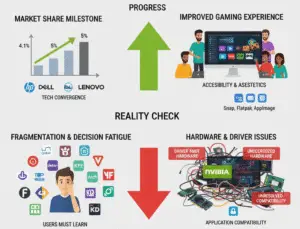
Hyperautomation in 2025: The Future of Smart Business

Introduction: When Machines Run Themselves
Imagine a business where invoices process themselves, customer service bots handle 80% of questions, and supply chains automatically adjust to problems. This isn’t the future—it’s hyperautomation, and by 2025, it will transform how every company operates.
This simple guide explains:
✔ What hyperautomation really means
✔ 5 ways it will change work by 2025
✔ Real examples you can see today
✔ How this affects jobs and prices
Hyperautomation Explained: The Office That Runs Itself
Imagine if your workplace could handle all the boring, repetitive tasks while you focus on the interesting stuff. That’s hyperautomation—combining AI, robots, and smart software to automate entire business processes, not just single tasks.
5 Ways Hyperautomation Will Transform Your Work Life by 2025
Hyperautomation isn’t just about speeding up tasks—it’s about reinventing how businesses operate. By combining AI, robotics, and smart software, companies are automating entire workflows, not just single steps. Here’s how it will change work in real, tangible ways.
1. The Self-Running Office
What’s Coming:
-
AI Email Assistants that read, prioritize, and even draft replies for you (e.g., Google’s Smart Reply suggests email responses)
-
Overnight Reporting where software generates sales summaries, financial forecasts, and performance reviews while you sleep
-
Smart Scheduling where AI books meetings based on your habits (e.g., Clockwise automatically blocks focus time)
Example Today:
-
Zapier automates workflows—like saving Gmail attachments to Google Drive without lifting a finger
-
Xero scans receipts and auto-categorizes expenses, eliminating manual bookkeeping
Why It Matters:
No more wasted hours on admin tasks—your workday becomes more strategic and less tedious.
2. Smarter Factories & Warehouses
2025 Vision:
-
Self-Adjusting Inventory – Robots restock items based on real-time sales (e.g., a hot-selling product gets front-row shelf space automatically)
-
Predictive Maintenance – Machines alert technicians before breaking down, avoiding costly shutdowns
Working Now:
-
Amazon’s Kiva Robots bring shelves to workers, cutting order processing time in half
-
Tesla’s Gigafactories use robotic arms that handle 90% of assembly tasks with precision
Why It Matters:
Faster production, fewer errors, and lower costs for businesses (which could mean cheaper products for you).
3. AI-Powered Customer Service
Big Change:
-
Bots That Actually Help – No more “I didn’t understand your question” loops; AI will troubleshoot complex tech issues
-
Human-Like Voice Assistants – Call customer service and you might not realize you’re talking to AI
Current Tech:
-
Bank of America’s Erica handles 50M+ customer chats yearly—resolving balance inquiries, fraud alerts, and more
-
Domino’s AI Voice Ordering takes pizza orders via phone calls (and even understands drunk mumbling!)
Why It Matters:
No more waiting on hold—instant, accurate help 24/7.
4. Error-Proof Paperwork
No More:
-
Lost invoices (AI tracks every document)
-
Manual data entry mistakes (bots copy info perfectly every time)
-
Weeks-long approvals (AI processes forms in minutes)
2025 Standard:
-
Self-Updating Contracts – Legal docs that adjust automatically when regulations change
-
Instant Mortgage Approvals – AI verifies income, credit, and property value in minutes
Example Today:
-
UiPath automates invoice processing, reducing errors by 90%
Why It Matters:
Less frustration, faster service—paperwork becomes painless.
5. The Always-Optimized Business
AI Magic:
-
Dynamic Pricing – Like Uber’s surge pricing, but for retail (e.g., a coffee shop raises prices during rush hour automatically)
-
Cost-Saving AI – Finds hidden inefficiencies (e.g., a cheaper shipping route that saves thousands per year)
Early Example:
-
Walmart’s AI Inventory System predicts demand so accurately that stockouts dropped by 30%
Why It Matters:
Businesses waste less, save money, and pass some savings to customers.
What This Means for You



How Hyperautomation Actually Works: Your Business on Autopilot
Imagine walking into an office where routine work magically completes itself – that’s hyperautomation in action. Here’s exactly how this technological symphony performs:
-
The Detective Phase: AI-Powered Discovery
-
Like a digital efficiency expert, special software:
-
Watches how employees work (with permission)
-
Identifies repetitive patterns (like copying data between systems)
-
Flags bottlenecks (where work gets stuck)
-
-
Real-world example: Celonis process mining software analyzed a bank’s loan approvals and found 40% of applications got delayed waiting for one manager’s signature
-
-
The Toolbox: Three Secret Weapons
a) Digital Workers (RPA):
-
Software robots that mimic human computer actions
-
Can work 24/7 without coffee breaks
-
Example: UiPath bots process insurance claims by extracting data from scanned documents and entering it into databases
b) The Brainy Assistant (AI/ML):
-
Learns from historical data to make predictions
-
Gets smarter with each task
-
Example: An AI at Hertz analyzes customer service calls to predict which customers might need extra help
c) The X-Ray Machine (Process Mining):
-
Reveals hidden inefficiencies in current workflows
-
Example: A hospital discovered nurses spent 2 hours per shift walking to supply rooms because of poor layout
-
-
The Magic Trick: Self-Improving Systems
-
Unlike traditional automation that just repeats tasks, hyperautomation:
-
Notices when patterns change (like sudden spike in customer complaints)
-
Adjusts its approach automatically
-
Suggests new optimizations
-
-
Case study: A European retailer’s system noticed weekend online orders had different patterns and created a separate workflow automatically
-
Why This Changes Everything:
-
Speed: Tasks that took hours now happen in minutes
-
Accuracy: Elimination of human error (no more typos in spreadsheets)
-
Adaptability: Systems evolve as your business changes
Think of it like this: If regular automation is teaching a dog to fetch, hyperautomation is training a service animal that learns your habits, anticipates your needs, and improves its performance daily.
Why Hyperautomation Matters to You (And What It Really
Means for Your Future)
For Workers: From Data Entry to Decision Making
-
Goodbye to mind-numbing tasks:
-
No more manually transferring numbers between spreadsheets
-
Never chase colleagues for signatures again
-
Stop wasting hours formatting reports
-
-
Hello to meaningful work:
-
Spend time analyzing data instead of collecting it
-
Focus on customer relationships rather than paperwork
-
Develop new products instead of processing orders
-
-
Real example: At a major insurance company, claims processors became “claims solution specialists” who handle complex cases while AI manages routine approvals.
For Shoppers: Service That Actually Serves You
-
Instant resolutions:
-
Return that wrong-size shirt by chatting with a bot that processes refunds in seconds
-
Get tech support that actually understands “my internet won’t work” at 2 AM
-
-
Personalized experiences:
-
Your favorite store automatically applies discounts you qualify for
-
Subscription services that adjust before you complain
-
-
Current reality: Amazon’s automated returns already process refunds before you even mail items back.
For Business Owners: Doing More With Less
-
Where the savings come from:
-
75% reduction in invoice processing costs (Deloitte findings)
-
90% fewer errors in inventory management
-
60% faster customer response times
-
-
Unexpected benefits:
-
Happier employees who quit less often
-
Better compliance with fewer mistakes
-
Ability to scale without proportional cost increases
-
-
Proof point: A mid-sized manufacturer automated purchase orders and saw 35% growth without adding administrative staff.
Honest Answers to Real Concerns
“Will I lose my job to a robot?”
-
Historical truth: When ATMs arrived, bank teller jobs actually increased 40% over 20 years
-
New opportunities emerging:
-
Automation coordinators ($85k average salary)
-
Process optimization specialists
-
AI-human collaboration managers
-
-
Your best move: Learn to work with AI tools (they’re just advanced Excel)
“Is this safe and reliable?”
-
Built-in protections:
-
Human approval gates for big decisions
-
Complete audit trails of every automated action
-
Regular “AI health checks” by ethics teams
-
-
Fail-safes in place:
-
Systems flag when they’re uncertain
-
Easy pause buttons for questionable situations
-
Multiple verification steps for critical processes
-
The Not-So-Distant Future (2026-2030)
-
Self-Correcting Systems:
-
Your accounting software notices a duplicate payment and reverses it automatically
-
Inventory bots reorder stock when they detect shifting trends
-
AI Leadership:
-
Algorithms handle routine business decisions like:
-
Adjusting staff schedules based on predicted demand
-
Optimizing delivery routes in real-time
-
Managing basic vendor negotiations
-
-
Complete Workflow Automation:
-
From “Add to cart” to delivery:
-
AI handles purchasing, warehousing, shipping
-
Robots pack orders
-
Self-driving vehicles deliver
-
-
Example: Alibaba’s fully automated warehouses already ship 1 million packages daily with just 3 human supervisors.
Your Action Plan
If You’re an Employee:
-
Master one automation tool this quarter (Try Zapier or Power Automate)
-
Identify repetitive tasks you can document for automation
-
Volunteer for AI pilot projects at work
If You Run a Business:
-
Start with high-volume, repetitive tasks (accounts payable is perfect)
-
Partner with automation specialists (not just IT teams)
-
Measure before/after metrics religiously
If You’re Just Observing:
-
Notice automation in your daily life (banking apps, retail)
-
Provide feedback when systems work well (or fail)
-
Stay open to new service models
The Big Picture
Hyperautomation represents the biggest shift in how we work since the industrial revolution. But unlike machines replacing manual labor, this revolution is about:
-
Freeing our time from repetitive tasks
-
Amplifying our unique human strengths
-
Creating space for the work that actually matters
The most successful people and companies won’t resist this change – they’ll learn to harness it. After all, the future belongs to those who can work smarter, not harder.




